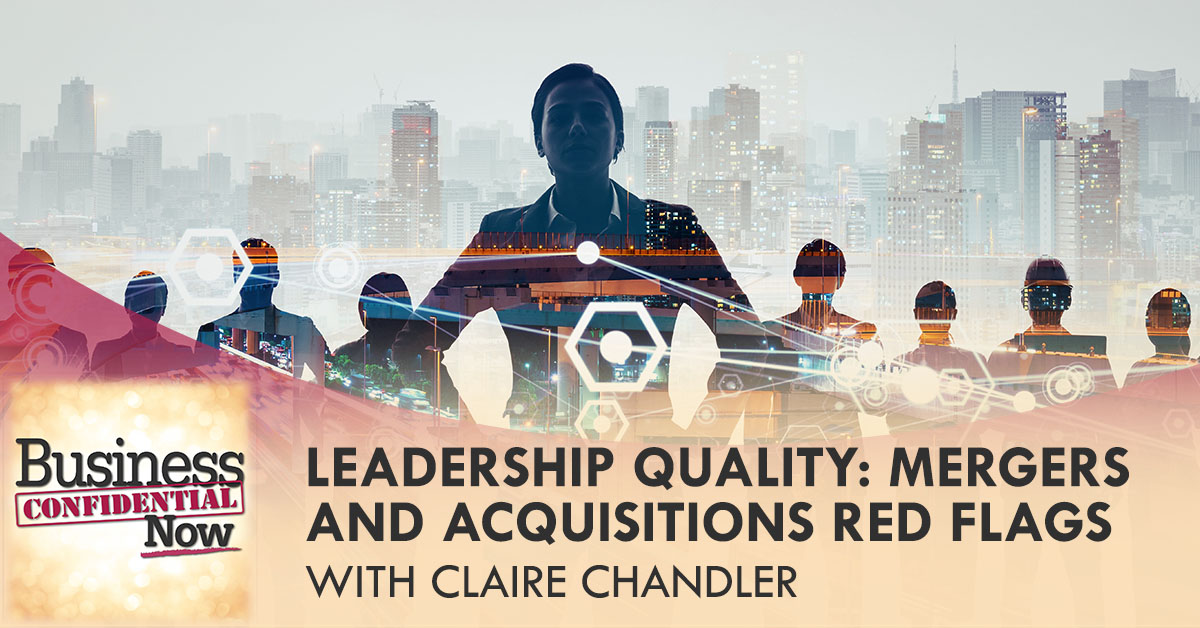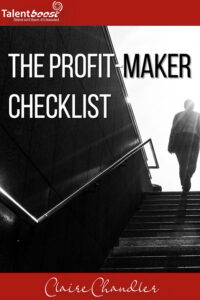
Photo Credit: © iStock | metamorworks
Leadership quality can make or break the success of your deal, according to today’s guest. So why isn’t it prioritized during due diligence when looking for mergers and acquisitions red flags? Claire Chandler is the President and Founder of Talent Boost and she specializes in leadership and business value creation. In this episode, she chats with Hanna Hasl-Kelchner to discuss the importance of looking at the leadership quality of an organization and how you can do just that. Yes, there are ways to measure these “intangible assets” and Claire shares these strategies with us. Tune in to learn all about them.
—
What You’ll Discover About Mergers and Acquisitions Red Flags:
- Leadership quality as part of due diligence
- The myth about not being able to measure leadership quality
- The most important M&A red flags when it comes to leadership quality
- When a business grows from luck versus skillful execution of strategy
- How to communicate intel with investors
- Her criteria for evaluating leadership quality
- Tips for interviewing someone in a leadership capacity
- The impact of hiring decisions in small organizations
—
—
Guest
 The President and Founder of Talent Boost, Claire Chandler specializes in leadership and business value creation. She taps into over 25 years of experience in people leadership, human resources, and business ownership to help the investment community identify the leaders and businesses of the future. She helps private equity firms acquire and future-proof the RIGHT businesses through management team due diligence, organizational design, acquisition integration and onboarding, and performance acceleration.
The President and Founder of Talent Boost, Claire Chandler specializes in leadership and business value creation. She taps into over 25 years of experience in people leadership, human resources, and business ownership to help the investment community identify the leaders and businesses of the future. She helps private equity firms acquire and future-proof the RIGHT businesses through management team due diligence, organizational design, acquisition integration and onboarding, and performance acceleration.
Claire gets results because she’s insanely easy to work with, cuts through the corporate clutter, and has a crystal-clear, proven approach for building your strategic growth roadmap, measuring the alignment and motivation of top management teams, and positioning companies for maximum success. Many in the investment community say they breathe easier when Claire is in the room.
One client sums up Claire perfectly:
“Claire is always calm in a crisis, always finds creative ways to solve problems, and is always professional—but only when it’s necessary.”
Claire holds a certificate in strategic HR leadership from Cornell’s School of Industrial and Labor Relations, a master’s degree from the New Jersey Institute of Technology, and a bachelor’s degree from Fairfield University. She has appeared as a guest on over 100 podcasts and is the author of several books on leadership and business strategy.
—
Leadership Quality: Mergers and Acquisitions Red Flags With Claire Chandler
M&A red flags about the quality of an acquisition targets leadership don’t always make it to the top ten on a due diligence list but my next guest says, “Leadership quality can make or break the success of your deal.” What do you need to look out for? How bad is bad? We will find out.
—
I’ve got a great guest for you to talk about M&A red flags. She’s Claire Chandler, the President and Founder of Talent Boost and the author of The Decision Dashboard. Claire specializes in leadership and business value creation, helping private equity firms acquire and future-proof the right businesses through the management team, due diligence, organizational design, acquisition integration, onboarding and performance acceleration.
She’s known for getting results because she’s insanely easy to work with and cuts through the corporate clutter. She’s got a crystal-clear proven approach for building your strategic growth map. She’s a no-nonsense gal, exactly my kind of person. I look forward to hearing and learning more about these leadership M&A red flags. Welcome to the show, Claire.
Thanks, Hanna. It’s so great to be here.

Mergers and Acquisitions Red Flags: Investors largely overlook or choose not to take an in-depth look at the people within their target companies for that very misconception that they cannot measure the capacity, the capability, and the motivation of people.
With M&A red flags and leadership quality, how do you go about measuring leadership quality? Isn’t it highly subjective?
That has to be one of the biggest myths about people. Human beings can’t be measured. I suspect it is why most investors don’t go anywhere near that as part of their due diligence but there are ways that we can, do and must measure the capability and the capacity of the people within the organization because we all know that without the right people, your business is going to fail.
I’m sure there are a lot of people that are hesitant and buy into that myth but still, what do you do? Do you put a thermometer on them? How do you measure?
That is a common misconception. I promise you that the way that I go about it in my framework and my methodology is far less invasive than a thermometer. It’s interesting because investors largely overlook or choose not to take a very close or in-depth look at the people within their target companies for the misconception that they cannot measure the capacity, capability and motivation of people. I would argue that is not true.
We can, should and must measure because people are what drive the business. There are studies that have shown that somewhere around 72% of the value of any business is driven by intangible assets. Those are things like the people, the brand, the intellectual property and the knowledge that is contained within any business. It stands to reason that we pay closer attention to that on the front end before we put our investment dollars or our heart and soul into a business.
The way that I go about it is I use a variety of tools but a couple that is very science-based diagnostic tools that enable me to collect data on an individual basis on exactly what the capacity and capabilities are of the individuals within an organization and as important, what motivates them because we know that investors can have a brilliant growth strategy. Any investor you talk to is going to tell you that their growth strategy for an acquisition is sheer brilliance.
They invariably come up against this frustration of cultural resistance that people dig their heels in. They don’t want to make the changes that the investor finds necessary to grow the business in the right way at the right pace in the right direction. We need to measure and understand what motivates individuals within that organization so that we can feed those motivators and accelerate their ability to buy into and contribute to that growth strategy.
There are studies that have shown that somewhere around 72% of the value of any business is driven by intangible assets. Those are things like the people, the brand, the intellectual property, the knowledge that is contained within any business. Click To Tweet
That’s great because it is a blended family when you’re merging two live organizations. It’s not just an asset acquisition. You’ve got this great methodology. Let’s check that box. With the results of your methodology, what in your experience are the most important M&A red flags when it comes to leadership quality?
There were a couple. We already touched upon, “Does this team especially at the leadership ranks?” You have to have enough depth of talent within an organization that you’re going to acquire. A lot of the investors that I work with are looking at relatively small target companies. We may not be talking about a huge organization but it’s important to make sure you’ve got the right leadership.
If you’re going to change out 1, 2 or more of those players in the top management team, it’s important to make the right changes for the right reasons and look for some of those red flags in terms of capability. One of the biggest red flags, quite honestly, is misalignment. You described it perfectly when you called the relationship between an investor and a portfolio company a blended family.
Even before you throw the unique personalities, personas, ambitions, strengths and weaknesses of the investor into the mix, you’ve got a bit of a family within the company already that you’re requiring. They may or may not be aligned. It’s just across their leadership team. Part of what we need to suss out is either before an investor makes that commitment to an acquisition or worst case as soon as possible after that deal closes and understand the level and the degree to which that leadership team is aligned.
One of the big questions that help us answer is, “Did they get from where they started to where they are now from strategic calculations and skill? Did they get here by luck?” Part of that is what we try to measure, uncover and explore with the investor. They truly know the raw materials or stuff that they have to work with. Stuff is a very technical term. I didn’t mean to get super technical but it is good stuff. This gray matter is not as black and white. Sometimes it’s a little bit harder to measure.

Mergers and Acquisitions Red Flags: We need to measure and understand what motivates individuals within that organization so we can feed those motivators and accelerate their ability to buy into and contribute to that growth strategy.
Luck can be pretty hard to get your arms around too. Can you give me an example of where the business grew from luck as opposed to a skillful execution of its strategy?
I mentioned a couple of these sorts of science-backed and science-based diagnostic tools but part of the way that I helped to fill in the edges of what that data tells me is by having one-on-one interviews with the top management team. Not in every acquisition do I have that luxury and that access. Oftentimes an investor only has direct access to the owner, as an example, who might be in the process of exiting.
As soon as they are able to bring me in either during the due diligence phase or very soon after the close of that acquisition, I then have one-on-one conversations with each of the leaders. For the people within an acquired company, this is where that cultural resistance starts right out of the gate because they immediately get their guard and defenses up and say, “You’re going to come in with your little clipboard and checklist and make me audition for my job.”
If you’re doing it the right way, 1) It doesn’t feel like that and, 2) That’s not the intention. The intention is to get your growth strategy implemented, bought into and accelerated to the degree that you can so you can take that company to the next level. Part of why you do that is by making sure that the blended family between the investor and the company is the right relationship because not all acquisitions are alike. You also have to make sure that you are getting into that marriage for the right reasons and with the right partner.
A lot of what those one-on-one conversations helped me to understand is back to this keyword around alignment. How much are all of the leaders on that top management team on the same page? Are they all bought into how this is the point in our evolution where we needed some outside help, funding and outright acquisition to grow to the next level? If so, are we growing in a direction that we all agree on?
It’s important to make the right changes for the right reasons. Click To Tweet
Part of these conversations helps you reveal how much all of them were on the same page, aligned and committed to some of the moves that they had made along the way to getting to this point in their growth evolution. Unfortunately, I don’t have a short answer to that question. The heart of the answer to that is you have to get to know the leaders and their motivations both for why they do what they do and for why they want to take their company to the next level.
Let’s suppose whether these conversations are held before or after closing. After closing, the stakes are a little different than before. You’ve uncovered something. One, two or maybe more of these leaders that you’ve interviewed don’t have the alignment. Maybe the motivation, the capacity, the capability and the things that you measure aren’t there. They’re some of your top red flags. You have to go to the investor. Are they quick to assume it our way saying, “We will work it out. Don’t worry about it?” How do you go about that conversation?
I’ve been fortunate enough that the investors that I choose to get into business with understand that the reason that they’re bringing me in is to bring them some of that intel that they would not otherwise have. It was being in a company that did a private equity study in 2021 on the state of their industry. They said around 92% of businesses underperform when they delay talent decisions. That’s a key factor. It was decisions around talent.
They didn’t make decisions about which accounting system to put in. It was decisions around the intangible asset that we talk about. It’s important because it does happen. When I bring the results of that assessment, those diagnostics, these one-on-one conversations and that management team’s due diligence, whether prior to the deal going through or shortly after, the investor sits up and takes notice because they have a couple of decisions to make. They’re armed with more data and hardline information than a gut feeling like, “This person is going to work out and that person will not.”
You’ve got a different decision to make because you were much better informed. The answer is not always passed or failed. Sometimes it’s about these leaders of the ten, let’s say, that we have spoken to and worked with. These three checked all the boxes and get it. They’ve got the capacity to get it at a deeper level to make the changes necessary and receive feedback, input and potentially criticism. They are coachable. That’s a key factor that we can measure.

Mergers and Acquisitions Red Flags: You have to get to know their motivations, both for why they do what they do and for why they want to take their company to the next level.
These three are ones that we want to keep on the team, get embedded in the growth strategy sooner than later and position as champions and change agents for the organization. Maybe there are another three that are potentially the right fit to make those sorts of contributions but maybe they’re not in the right role. Those roles can evolve. Maybe they were in the right role pre-acquisition and their skills, motivations, attributes and styles are better suited to a different role in this acquired organization.
There’s the component of how these are leaders that given where you want to take the organization, the level of change that will be required, the leadership presence they need to have or the aptitude they need to demonstrate are not bought in enough. They don’t have the capacity, emotional glue, commitment or buy-in. It would be very difficult and drawn out to try to get them there.
That’s part of the intel. We will sit down with an investor to review with them and arm them with that information so that they can make better decisions about the leaders that they have and make more intentional moves in terms of putting the people in the right roles but also building that buy-in and commitment earlier on in the process than they would otherwise do.
That’s a tall order though. I’m glad that you have all of these proprietary tools to help you and are also working with investors who are willing to listen. That’s an important factor because if they’re willing to assume it away, then all that work is for naught. I like what you’re talking about.
It’s a must-have criterion for both sides that they will listen to that advice. It’s something you can tell pretty early on when you’re talking with some of the investors. Some investors get it. Some investors don’t get it yet but want to get it and some investors are not my clients.
The ripple effects of a poor decision or a delayed decision in a smaller organization are far larger than in a big organization. Click To Tweet
That’s fair. That’s one way to sort them out. I’m listening to all of this and what you’re saying about leadership quality. I love the criteria that you’re looking at but it also occurs to me that it’s taking and transferring this outside of the M&A red flag situation to a hiring situation for a smaller business that doesn’t have the financial wherewithal to be able to afford a lot of leadership mistakes because it has a tremendous impact on the success and viability of an organization to grow. Do you have some tips that a mid-sized or a smaller business owner could adapt when they’re doing their interview process for someone in a leadership capacity in their organization?
I am so happy you went there with this conversation. To your point, the ripple effects of a poor decision or a delayed decision in a smaller organization are far larger than in a big organization or in an organization that is backed by the deep pockets of an investor. It’s a very important point that you are bringing up through your question. I have some clients that are not in the investment community. They are smaller companies that are trying to get ready to grow and scale either on their own or through the help of an investor yet to be identified.
We go through most of the same methodology and framework of measuring, sizing up and evaluating what is their current readiness to grow, scale and if they so choose to take on an investor. Part of what we do with that is we’re collecting all of this data around what are the key strengths that you have in your organization. It’s important to understand too that key strengths are not the same in every organization, in the people you have and fundamentally that you need in one organization compared to another.
The way that we ferret that out is we get very clear on what is your mission both now and where you want to be down the road, whether that’s 5 years or 12 months down the road. Where are you trying to get to? Once we’re clear on that, we come up with a list in inventory like, “That’s the mission. That’s the destination. What do you have to have? What is mission-critical in terms of your capabilities, strengths and attributes?”
Once we have that list, then we can evaluate the people that you have, especially at the leadership level and understand where the gaps are. To come back to your question, that becomes your hiring or screening criteria because the last thing you want to do, especially as a small organization, is to hire more people who look like you, talk like you, act like you and are strong in the areas that you’re already strong in.

The Decision Dashboard: Run your business from ONE sheet of paper
Use those hiring decisions to bring in people that have strong chemistry with you from a strategy and a brainstorming perspective and can mesh well with the personalities you’ve already got but who possess the strength in those fundamental attributes that you currently lack. That measurement piece is very important. I would argue it’s even more critically important for a small organization to who the ripple effect of making a poor hiring decision is far greater than in a larger organization that could perhaps absorb a bad hire or a misplaced leader.
You’ve written a book called The Decision Dashboard. What would be the reader’s biggest takeaway from that book? What do you want them to get out of it?
The Decision Dashboard takes the meat of my methodology. It’s a super-concentrated version of a do-it-yourself building your growth readiness platform. In my experience, research and client work, the biggest landmines to growth for lack of clarity and preparedness are those types of landmines where people don’t fully understand where it is they’re trying to get to, what they possess, what they need to fill in and how to go about doing that so that they can take 4 steps forward and maybe 1/2 step back versus 1 step forward and 2 steps back through bad, misguided or solely gut-level decisions. If you take away nothing else from that book, it’s that you need to start with getting absolute crystal-clear clarity on where it is that you’re trying to go and grow as an organization.
Claire, thanks so much. You’ve given us not just great insights about M&A red flags and leadership quality but also ways to think about it. Thank you for that. I appreciate all that you do. It sounds like there’s a lot of great information in there and a sneak peek behind the curtain of her methodology. If you know someone who needs help identifying M&A red flags, please tell them about this episode, share the link and leave a positive review so others can learn more too. Thank you for reading. Have a great day and an even better tomorrow.
Important Links
- Talent Boost
- The Decision Dashboard
- https://www.LinkedIn.com/in/ClaireChandlersphr/
- https://www.Twitter.com/TalentBoost
- More episodes about Risk Management & Law like this
Join, Rate and Review
Rating and reviewing the show helps us grow our audience and allows us to bring you more of the rich information you need to succeed from our high powered guests. Leave a review at Lovethepodcast.com/BusinessConfidential
Joining the Business Confidential Now family is easy and lets you have instant access to the latest tactics, strategies and tips to make your business more successful.
Follow on your favorite podcast app here as well as on Twitter, Facebook, YouTube, and LinkedIn.
Download ♥ Follow ♥ Listen ♥ Learn ♥ Share ♥ Review ♥ Comment ♥ Enjoy
Ask Questions or Recommend a Topic/ Guest:
Use our convenient Get in Touch form
OR e-mail feedback(at)BusinessConfidentialRadio.com
_________________________________________________________________________________________________________________________________
Disclosure:
This post may contain links to products to products on Amazon.com with which I have an affiliate relationship. I may receive commissions or bonuses from your actions on such links, AT NO ADDITIONAL COST TO YOU.
Join, Rate and Review:
Rating and reviewing the show helps us grow our audience and allows us to bring you more of the rich information you need to succeed from our high powered guests. Leave a review at Lovethepodcast.com/BusinessConfidential
Joining the Business Confidential Now family is easy and lets you have instant access to the latest tactics, strategies and tips to make your business more successful.
Follow on your favorite podcast app here as well as on Twitter, Facebook, YouTube, and LinkedIn.
Download ♥ Follow ♥ Listen ♥ Learn ♥ Share ♥ Review ♥ Comment ♥ Enjoy
Ask Questions or Recommend a Topic/ Guest:
- Use our convenient Get in Touch form
- OR e-mail feedback(at)BusinessConfidentialRadio.com
Disclosure:
This post may contain links to products to products on Amazon.com with which I have an affiliate relationship. I may receive commissions or bonuses from your actions on such links, AT NO ADDITIONAL COST TO YOU.
